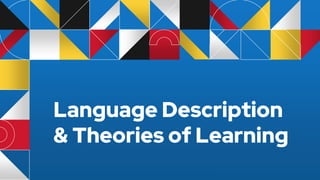
Kelompok 3.pptx
- 1. Language Description & Theories of Learning
- 2. Group 3 RINDI YANI DENY FERDIANSAH Motto Hidup : Kalau Bisa 2, kenapa harus 1. Motto Hidup : Kalau Bisa nanti, Kenapa harus sekarang.
- 3. Theories of learning is the conceptual framework describing how information is absorbed, processed ang retained during the learning. Learning language means the understanding structure and the processes of the mind. Unfortunately, we know about the people thinking.
- 5. LANGUAGE DESCRIPTIONS The ideas are drawn from the various language descriptions that have been developed by succeeding schools of thought in Linguistics. The important thing, we can aplly the suitable approach to get our goal
- 6. 1. Clasical or Traditional Grammar These descriptions were based on analysis of the role played by each word in sentence. Language were described in this way because the classical language were care- based language where the grammatical funcionts have different use of appropriate approach. 2. Structural Linguistics Language is described in terms of syntagmatic structures which carry the fundamental propositions (statement, interrogative, negative, imperative, etc.) and nations (time, number, gender, etc). There are large areas of language use that can’t explain. It may fail to provide the learner with understanding of the communicative use of the structures
- 7. 3. Transformational Generative (TG) Grammar There must be two levels of meaning from Chomsky: a deep level and a surface level. A deep level, which is concerned with the organization of thoughts. Meanwhile the surface level, where these thoughts are expressed through the syntax of language. 4. Language Variation and Register Analysis The concept of language variation gave rise to the type of ESP, which was based on register analysis. Register analysis has proved to be an insubstansial basis.
- 8. 5. Functional or Notional Grammar Functions are concerned which social behavior and represent the mention of the speaker or writer. 6. Discourse (Rhetorical) Analysis a. The sociolinguistics context (the relationship between participants and their reasons for speaking) b. the discourse meaning (the utterance acquires meaning by virtue of what utterances it precedes or follows)
- 10. a. Behaviourism The first coherent theory of learning was the behaviourist theory based mainly on the work of Payboy in Soviet Union and of Skinner in the United State. The are some precepts such as: 1. Never translate 2. New language should always be dealt with in the sequences: hear, speak, read, write 3. Frequence repetition is essential to effective learning 4. All errors must be immediatelly correct Principles of behaviourism or is called of operant conditioning
- 11. b. Mentalism (Thinking as rule-governed activity) In this case learning as rule-governed activity or learning consist not of forming habits but of acquiring rules a process in which individul experiences are used by the mind to formulate a hypothesis. c. Cognitive code Learning is a process in which the learner actively tries to make sense of data, learning can be said to have taken place when the learner has on the data. The basic teaching technique associated with acognitive theory of language learning is the problem solving task.
- 12. d. The affective factor (learner as emotional being) In this theory, learner try to combine the emotional factor and cognitive theory in order to take success or otherwise of a language learning experience. 1. Intrumental motivation Instrumental motivation is the reflection of an external needs. It means the learner are not learning a language because thy want to, but they need to 2. Integrative motivation A desire on the part of the learners to be members of the speech community that uses a particular language. In this case the learner learns the language because they use it as communicative speech to the others. The learner to be members of the speech community that use a particular language. It is an internally generated want rather than an externally imposed need.
- 13. e. Learning and acquisition In this case, learning is seen as a concious process, while acquisition proceeds unconciously. It means that when people learning language, automatically they will acquire it in unconsciously. That is why the both terms are interchangably f. Model for Learning Model of learning will provide a pretical source of reference for the ESP teacher and course design. It is a picture that combine all parts of learning process.
- 14. CONCLUSION The Language Description is the way in which in the language system is broken down and described for the purposes of learning. The Theories of learning relates to the development in approaches to learning and considered their relevances to ESP. We still do not know very much about learning.